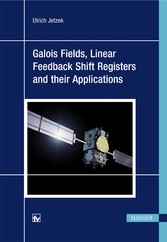
Ulrich Jetzek
Galois Fields, Linear Feedback Shift Registers and their Applications
Contents
10
1 Introduction
14
2 Finite Groups and Fields
18
2.1 Modular Arithmetic
19
2.2 Groups, Rings and Fields
21
2.3 Galois Fields
24
2.3.1 Prime Fields
26
2.3.1.1 Existence of Prime Fields
26
2.3.1.2 Generators of Prime Fields
28
2.3.1.3 Multiplicative Inverses in Prime Fields
29
2.3.1.4 Cyclic Structure of Prime Fields
30
2.3.2 Extension Fields
32
2.3.2.1 Existence of Extension Fields
33
2.3.2.2 Irreducible Polynomials
34
2.3.2.3 Modular Arithmetic over Polynomials
37
2.3.2.4 Primitive or Generator Polynomials
38
2.4 Lessons learned
42
2.5 Exercises
44
3 Working with Extension Fields
46
3.1 Primitive Polynomial Representations
46
3.2 Addition over Extension Fields
48
3.3 Multiplication over Extension Fields
50
3.3.1 Multiplication in polynomial form
50
3.3.2 Multiplication by means of string representation
51
3.3.3 Multiplication using the primitive polynomial
52
3.4 Multiplicative Inverse within Extension Fields
53
3.5 Lessons learned
55
3.6 Exercises
56
4 Linear Feedback Shift Registers
60
4.1 Ring Counters
61
4.2 Johnson Counters
62
4.3 Design of Linear Feedback Shift Registers Based on Galois Field Theory
64
4.3.1 Design of linear feedback shift register circuits based on primitive polynomials
65
4.3.2 LFSRs based on irreducible (non-primitive) polynomials
68
4.3.3 LFSRs based on reducible polynomials
71
4.4 Further topics related to linear feedback shift registers
73
4.4.1 Checking if a specific polynomial is primitive, irreducible or reducible
73
4.4.2 A systematic way of how to determine primitive polynomials
77
4.5 Lessons Learned
79
4.6 Exercises
80
5 Correlation Functions and Pseudo-random Sequences
82
5.1 Correlation Functions
85
5.2 Maximum Length Sequences (m-Sequences)
90
5.3 ‘Real’ random sequences and their properties
92
5.4 Properties of m-Sequences
93
5.5 Lessons learned
94
5.6 Exercises
95
6 Applications of Galois Fields and Linear Feedback Shift Registers
98
6.1 LFSRs within the Global Positioning System (GPS)
98
6.1.1 The Positioning Principle of GPS
99
6.1.2 GPS codes
100
6.1.3 C/A-code generation within the Global Positioning System (GPS)
101
6.1.4 P-code Generation within the Global Positioning System
106
6.2 Data Transmission in GPS
111
6.2.1 The spreading principle
113
6.3 LFSRs in GALILEO
120
6.3.1 Motivation behind GALILEO
120
6.3.2 History of GALILEO
122
6.3.3 GALILEO Services
123
6.3.4 GALILEO and GPS comparison
126
6.3.5 GALILEO open-service (OS) system codes
126
6.4 LFSR Applications in Cryptography
133
6.4.1 A5/1 – a stream cipher used in GSM
138
6.4.2 Trivium
141
6.5 Cyclic Redundancy Checks (CRC) Using LFSRs
142
6.5.1 The core idea of CRC
142
6.5.2 The mathematical description of CRC
143
6.5.3 Implementation aspects of CRC
149
6.5.4 Optimizing CRC-calculation
152
6.6 Lessons learned
156
6.7 Exercises
158
7 Appendix
160
7.1 Problem Solutions
160
7.1.1 Solutions to problems in Chapter 2
160
7.1.2 Solutions to problems in Chapter 3
162
7.1.3 Solutions to problems in Chapter 4
166
7.1.4 Solutions to problems in Chapter 5
170
7.1.5 Solutions to problems in Chapter 6
172
7.2 List of primitive and irreducible polynomials
172
Index
180
© 2009-2024 ciando GmbH
 Zu Hanser-Fachbuch.de
Zu Hanser-Fachbuch.de
 Warenkorb
Warenkorb